UK Roof Repair Cost Estimator Guide
- Dan Hall
- Aug 5
- 13 min read
Feeling that sense of dread when you spot a problem with your roof is something most homeowners can relate to. The big question looming is always, "How much is this going to set me back?" While there's no magic number, using a roof repair cost estimator mindset can make a huge difference. On average, a typical roof repair in the UK will cost around £600, but this is just a starting point.
The final figure can swing wildly depending on the extent of the damage, the materials on your roof, and even where you live.
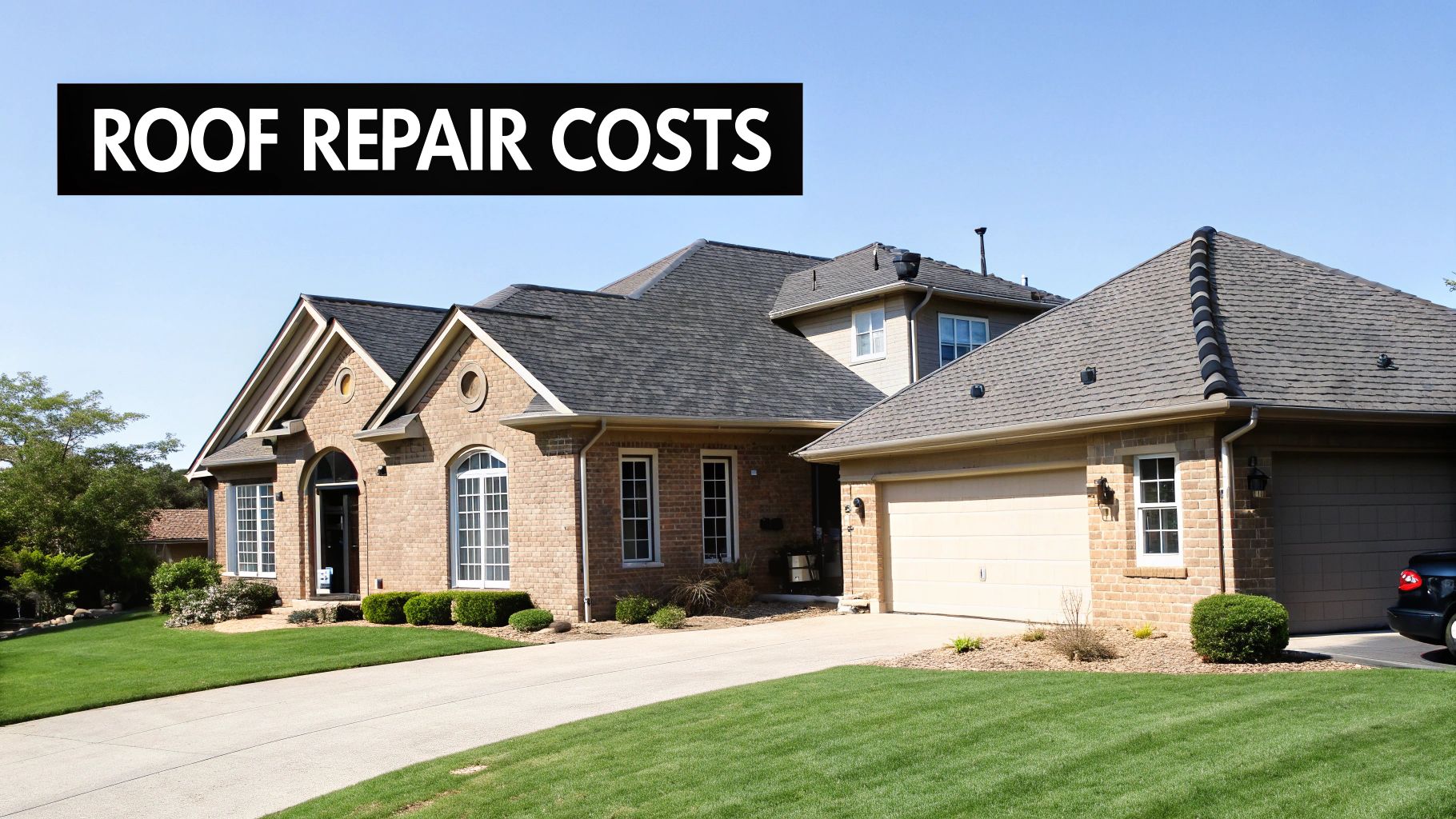
A Realistic Look at UK Roof Repair Costs
Before you start getting quotes, it helps to understand what drives the price of roof repairs across the UK. Think of it less as a fixed price and more as a tailored service. Your home's location, the specific type of roofing you have, and, crucially, the severity of the problem all play a major role in any accurate roof repair cost estimator.
For example, a few slipped or cracked tiles might be a relatively quick and minor fix. On the other hand, if you're dealing with serious water damage or a sagging roof structure, the job naturally becomes more complex and costly. This is exactly why having a baseline knowledge is so valuable—it helps you know what to expect.
Quick Guide to Average UK Roof Repair Costs
To give you a clearer picture, here's a look at some of the most common repair jobs we see and their typical cost ranges. Keep in mind these are ballpark figures, but they provide a helpful starting point for your own roof repair cost estimator.
Type of Repair | Typical Cost Range (£) |
|---|---|
Minor Leaks (e.g., around flashing) | £100 – £300 |
Replacing a Few Broken or Slipped Tiles | £150 – £350 |
Replacing Damaged Underlay (Felt) | £30 – £40 per m² |
Repairing a Sagging Roof Structure | £500 – £2,500+ |
Repointing a Chimney Stack | £400 – £1,000 |
Fixing Leaking Valleys or Gullies | £300 – £600 |
This table shows just how much the scope of work impacts the final bill. A small, localised repair is one thing, but anything involving the roof's underlying structure will always require more investment.
Knowing these figures gives you a crucial reference point. It empowers you to spot a fair quote from an unreasonable one and helps you plan your finances without any nasty surprises.
So, Why Do Estimates Vary So Much?
The final bill from any roofer is a combination of several key factors. Labour costs are a big one, and they can differ significantly by region—contractors in London and the South East, for instance, generally have higher rates. This regional difference is a vital part of any roof repair cost estimator.
The complexity of the job also adds to the cost. Working on a very steep roof, navigating around skylights, or dealing with difficult access all require more time, specialist equipment, and skill.
Ultimately, the only way to get a firm price is to have a professional take a look. Moving from general averages to a concrete number for your project is key. For a tailored quote that reflects your specific situation, you can get a detailed **roofing estimate** from our experienced team. It’s the best way to understand exactly what your repair will involve.
How to Assess Your Roof Damage Safely
Figuring out a reliable roof repair cost starts long before you get a quote. It begins with a careful, and most importantly, safe assessment of the damage. Before you can even think about budgeting, you need to understand the scale of the problem you're facing. The good news? You can do most of this initial check-up without setting foot on a ladder.
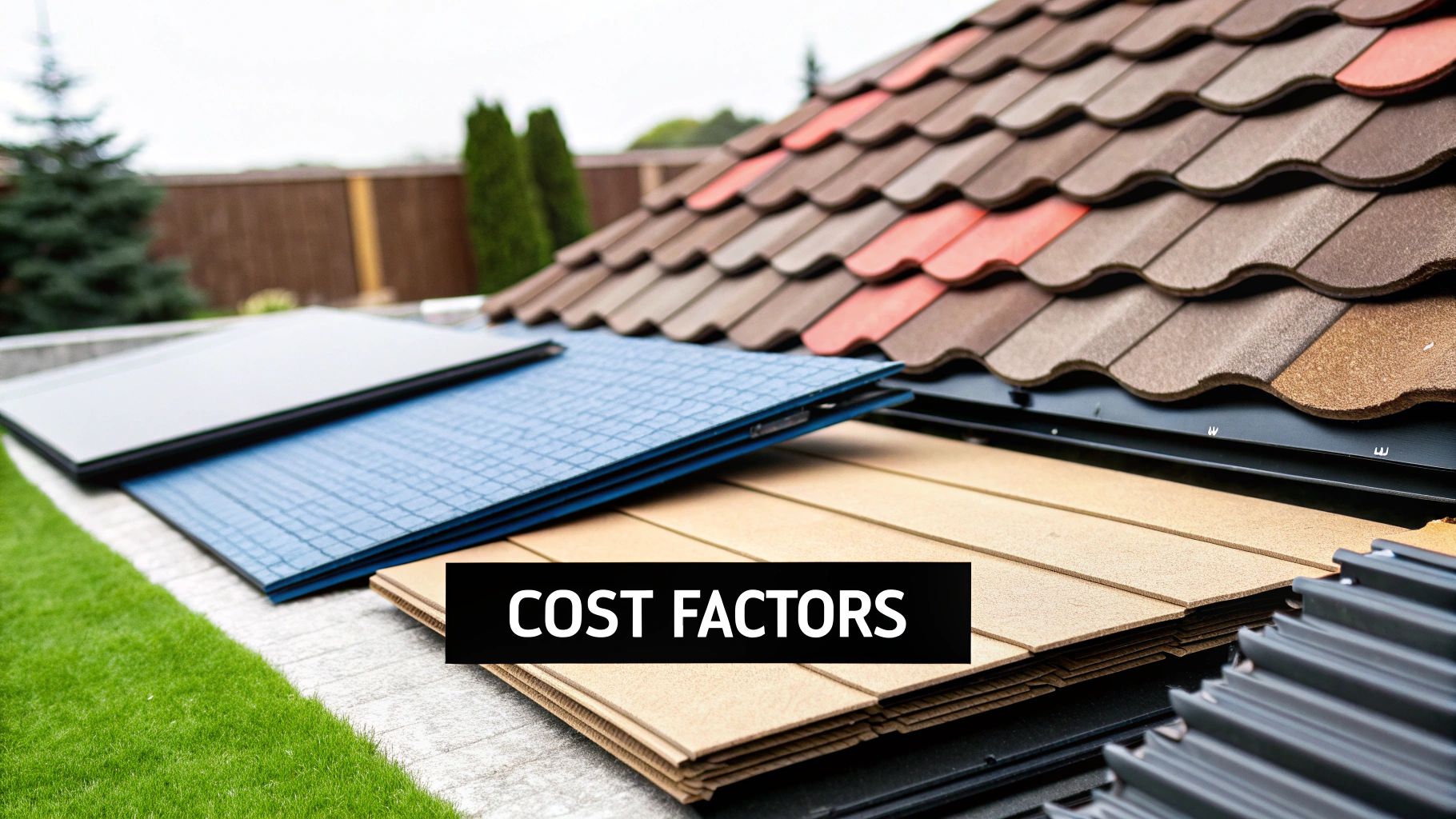
Your safety is paramount. Professionals have the right training and safety gear for a reason. But from the ground, a good pair of binoculars can tell you a surprising amount. This initial check gives you the information you need to have a much more productive conversation with a contractor later on.
Your Ground-Level Inspection Checklist
Pick a clear, dry day and walk around the entire perimeter of your property. Don't rush it. Use your binoculars to get a close-up view of the roof's surface from every possible angle. You’re essentially looking for anything that seems out of place or damaged.
Here’s what professional roofers like us are trained to spot from the ground:
Slipped, Cracked, or Missing Tiles: Scan for obvious gaps or any tiles that aren't lying perfectly flat. These are the most common culprits for letting water in.
Damaged Flashing: Pay close attention to the thin metal strips around your chimney, any roof vents, and skylights. Are there any signs of peeling, rust, or noticeable gaps?
Granule Loss from Shingles: If you have asphalt shingles, look for dark patches where the gritty, protective granules have worn away. You'll often find these sandy granules collecting in your gutters, too.
Clogged or Damaged Gutters: Gutters overflowing with leaves and debris can cause water to back up and seep under the edge of your roof, leading to rot. Look for any blockages or sections that are sagging under the weight.
Moss or Algae Growth: While a bit of green isn't always a five-alarm fire, heavy growth can trap moisture against the roof surface. Over time, this accelerates wear and tear.
A thorough ground-level inspection can reveal 80% of common roof problems. Documenting these issues with photos will be incredibly helpful when you speak to a roofing contractor, ensuring nothing gets missed.
Looking for Clues Inside Your Home
Sometimes, the most revealing signs of a roof problem aren't on the roof at all. Your loft or attic is the next logical stop, as it offers a direct view of the roof's underside. Always prioritise safety here; make sure the area is well-lit and that you have stable, safe footing before you move around.
Once you're safely inside, turn off the lights. Look up and scan for any slivers of daylight poking through the roof boards—these are direct-line-of-sight to holes.
Next, grab a torch and methodically scan the rafters and insulation for these tell-tale signs:
Water stains or dark, streaky marks on the timber.
Insulation that looks damp, compressed, or has signs of mould.
A distinct musty or damp smell in the air.
Spotting these issues early helps you understand whether you're looking at a simple tile replacement or a more complex problem involving the roof’s underlying structure. This knowledge is crucial for building a more accurate preliminary roof repair cost estimator before you call in the experts.
Calculating Your Material Costs Accurately
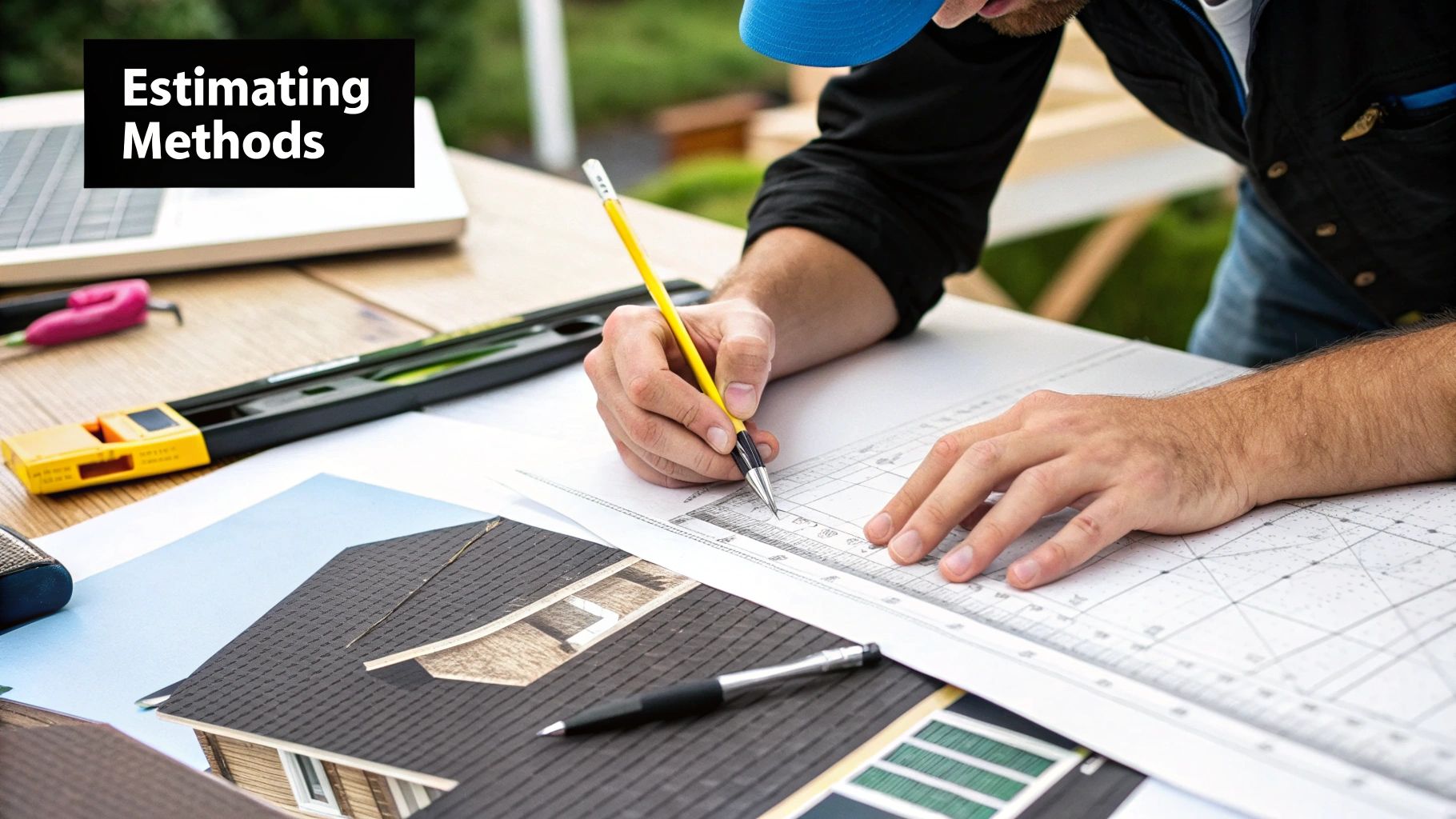
A huge chunk of your final repair bill will be the materials themselves. To build a reliable roof repair cost estimator, you first need to get a firm handle on what those supplies will set you back. This means getting your measurements right for the damaged patch and translating that into the correct number of tiles, how much underlayment you need, and all the other essentials.
The single biggest factor influencing the cost is the type of material already on your roof. There's a world of difference in price between a standard concrete tile and a premium Welsh slate, for instance. Nailing this part of your estimate is the key to creating a realistic budget and dodging any nasty surprises when the final invoice lands.
Measuring the Repair Area
First things first, you need to work out the size of the repair in square metres (m²). If it’s a straightforward rectangular patch on an easy-to-reach part of the roof, you might be able to measure it safely from a ladder or even make a decent guess from the ground. For example, a small damaged section might be 2 metres wide by 1.5 metres long, giving you a repair area of 3 m².
But it gets a lot trickier with odd shapes or bigger sections. This is where a professional roofer is worth their weight in gold, as they can measure everything precisely without putting themselves at risk. They'll also factor in the roof's pitch, which adds to the surface area compared to a simple flat measurement.
Pro Tip: Always, always add a waste factor to your material order. We recommend adding an extra 10-15% to your total. This buffer covers any cuts, accidental breakages, and minor mistakes, saving you from a last-minute panic-buy at the supplier.
Comparing Common UK Roofing Materials
Material costs can swing wildly depending on the quality, brand, and even where you are in the country. A leak is often the first clue you need a repair, and the final price will hang on the extent of the damage and your roof type. To give you a ballpark, roof repair costs in the UK for a pitched clay tile roof often fall between £110 and £160 per square metre. That figure includes materials, labour, and other bits and bobs. You can get more insights on how these costs break down over at Checkatrade.com.
Let's look at some typical material-only costs for popular choices here in the UK:
Concrete Tiles: These are usually the most wallet-friendly option, coming in at around £20-£35 per m². They're tough and available in loads of styles.
Clay Tiles: A more traditional and, let's face it, prettier choice. Clay tiles typically cost between £35-£65 per m² and offer fantastic longevity.
Natural Slate: At the top end of the scale, natural slate can be anywhere from £50 to over £100 per m². The price depends on whether it's a good quality import or premium Welsh slate.
Don't Forget the Essentials
Your shopping list doesn't stop at tiles or slates. For a proper, long-lasting fix, you have to remember to price up these crucial components too:
Breathable Underlayment (Felt): This is the waterproof membrane that sits under the battens, acting as your roof's second line of defence against water.
Roofing Battens: These are the treated timber lengths fixed to the rafters that your tiles hang from.
Fixings: This bucket includes specific nails for your battens and tiles, plus any clips needed for high-wind areas.
Forgetting these items is a classic DIY mistake that can completely throw your budget out of whack. A detailed list of every single component is your best friend for building a roof repair cost estimator you can actually rely on.
Where Your Money Really Goes: Labour and Hidden Costs
Once you've got a handle on material costs, the next big piece of the puzzle is labour. This is often where quotes can look wildly different from one roofer to another. It’s not just about the hours someone spends on your roof; it’s a reflection of their experience, insurance, and all the costs of running a professional business.
Getting to grips with how roofers price their time is crucial for any roof repair cost estimator. A roofer’s day rate in London or the South East will almost always be higher than in other parts of the UK. It’s a simple case of supply, demand, and the higher costs of operating in those areas.
But it's not just about location. The job itself is a massive factor. Replacing a few tiles on a bungalow is a world away from tracking down a persistent leak on a steep, three-storey townhouse. One is a quick fix; the other is a complex, high-risk job.
What Pushes Labour Costs Up?
Several things directly affect how much time and skill your repair will need, and a good roofer will factor all of them into your quote.
Ease of Access: Can a roofer get to your roof easily? A terraced house with no back garden or a particularly high roof immediately means more time and specialised equipment.
Roof Pitch: The steeper the roof, the more dangerous the work. This calls for extra safety gear like harnesses, which naturally slows down the pace and increases the labour charge.
Job Complexity: A simple tile swap is one thing. Repairing a leak around a chimney stack or a Velux window is a different beast altogether. These jobs need a much higher level of precision and skill.
Remember, a roofer's rate isn't just for their time on site. It covers their public liability insurance, fuel, tool maintenance, and years of hard-won experience. All of this ensures the job is done right and, most importantly, safely.
Don't Forget the "Hidden" Expenses
A classic homeowner mistake is to budget only for the materials you can see and the labour you expect. But a professional, safe roofing job has other essential costs that can add up. A trustworthy roofer will always list these out for you.
These aren’t optional extras; they are often legal or practical necessities. For example, scaffolding is frequently a legal requirement under UK health and safety laws for any work at height. It’s there to protect the workers and the public. This alone can add hundreds of pounds to the final bill. For bigger projects, it's vital to see the whole picture; exploring what goes into a **full renovation estimate** shows how all these moving parts come together.
Other common costs you need to plan for include:
Skip Hire: To get rid of old materials like broken tiles, rotten battens, and worn-out felt.
Emergency Call-Out Fees: If you need a repair done urgently outside of standard business hours, expect to pay a premium for the convenience.
Specialist Equipment Hire: Some jobs might need specific kit, like a tile hoist for a large repair or a cherry picker for tricky access.
If you don't account for these, your budget will fall short. Any good roof repair cost estimator must include every potential expense to give you a realistic idea of the total investment needed.
Repair or Replace? Making the Right Financial Call
When you first spot a roof problem, your immediate thought is probably "how much to repair this?" But sometimes, a quick patch-up is like putting a plaster on a deep wound—it's a temporary fix for a much bigger, underlying issue. The real question every homeowner needs to tackle is whether a repair makes sense or if you're just delaying the inevitable cost of a full roof replacement.
Getting this call right isn’t just about the immediate bill; it’s a major long-term financial decision. A good roof repair cost estimator should do more than just tally up materials; it should help you see the bigger picture. Pouring money into fixing an old, failing roof can quickly become a false economy, where one repair bill just leads to the next.
Key Factors in Your Decision
So, how do you decide? It comes down to a few critical factors that go well beyond a single leak or a handful of broken tiles. A methodical look at your roof's condition can save you thousands in the long run.
Here's what to consider:
Age of the Roof: Most roofing materials have a predictable lifespan. If your roof is getting on in years and nearing the end of its expected service life, a full replacement is often the smarter choice, even if the current damage seems minor.
Extent of Damage: A good rule of thumb we use in the industry is the 25% rule. If more than a quarter of your roof is damaged or showing serious signs of wear, a full replacement is almost always more cost-effective than trying to patch up such a large area.
Recurring Problems: Are you chasing the same leaks over and over? Persistent issues are a massive red flag. They often mean the underlying membrane or structure is failing, and simply patching the symptoms won't cure the disease.
The decision to replace your roof isn't just about stopping a leak today. It’s about securing your property's value and protecting it from far more expensive water damage for the next 20 to 30 years.
Comparing the Financial Impact
Of course, cost is a huge part of the equation. In the UK, a new roof is a significant investment. The average cost sits at around £7,000, but this can swing anywhere from £4,000 to £19,000 depending on the size, complexity, and materials.
The choice of material makes a massive difference. For instance, a new flat roof might cost between £2,800 and £7,500, whereas a premium slate roof can easily top £10,000. If you're looking for a detailed breakdown, this comprehensive 2025 roofing cost guide is an excellent resource.
The table below gives you a clearer idea of how the costs stack up for different materials, helping you weigh your options.
Roof Repair vs. Replacement Cost Comparison
Roof Type | Average Repair Cost (per m²) | Average Full Replacement Cost (per m²) |
|---|---|---|
Asphalt Shingles | £20 - £40 | £80 - £120 |
Clay or Concrete Tiles | £30 - £60 | £150 - £250 |
Slate | £50 - £100+ | £200 - £400+ |
Metal | £25 - £50 | £120 - £200 |
Flat Roof (Felt/EPDM) | £40 - £70 | £90 - £150 |
As you can see, while repairs are cheaper upfront, the cost of replacing can be four or five times higher per square metre. That's why making the right call early on is so crucial.
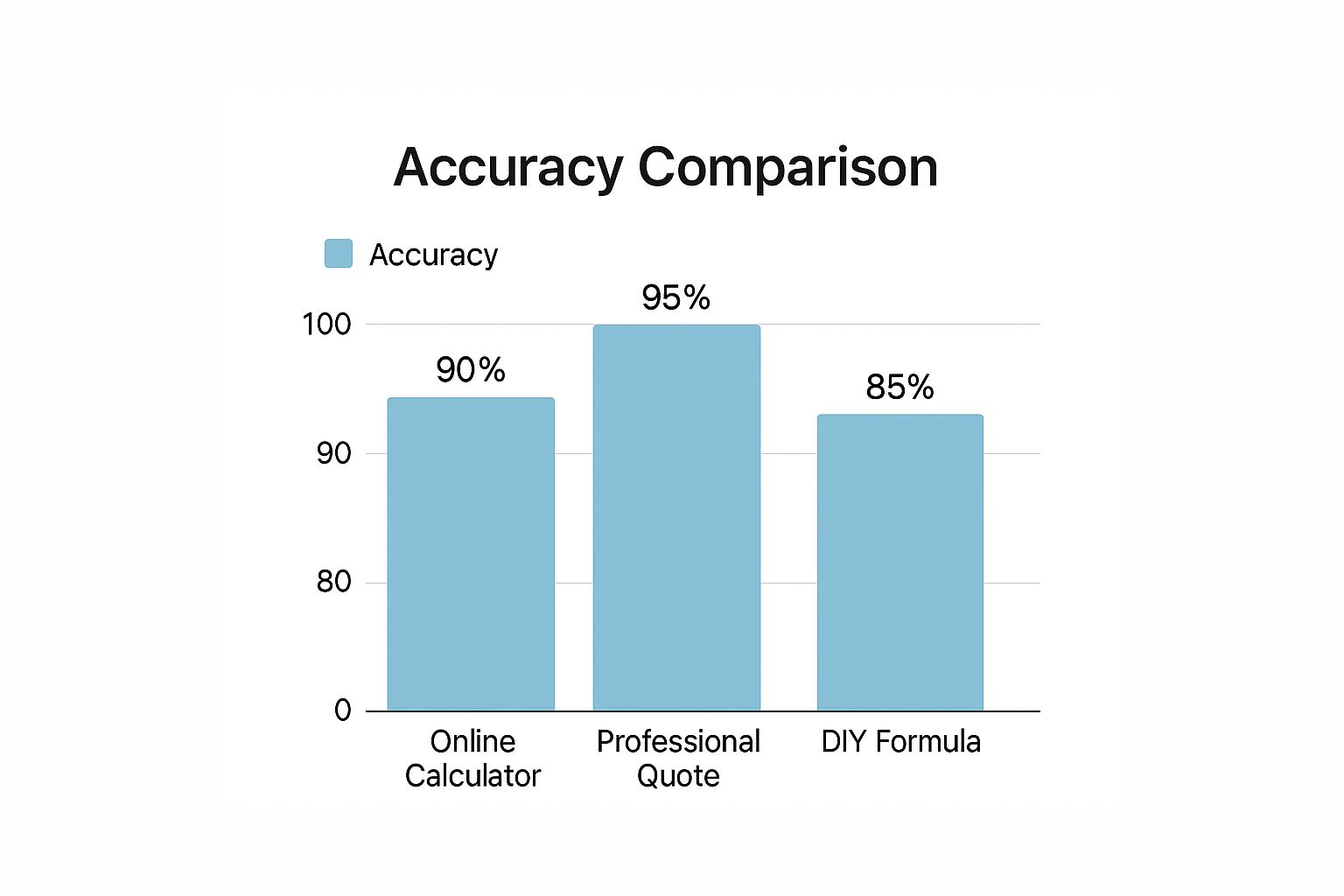
This data shows that while online tools are surprisingly accurate for a ballpark figure, nothing beats a professional quote for true financial planning. This is especially true when you're facing a project as significant as a full roof replacement.
Ultimately, choosing between repair and replacement is about balancing the short-term spend against the long-term security and value of your home.
Got More Questions About Roof Repair Costs?
As you start to pin down your budget, it’s completely normal to have a few last-minute questions. Getting your head around all the details of a roof repair cost estimator can feel a bit much, but getting clear answers is what gives you the confidence to move forward. We’ve pulled together some of the most common questions we hear from UK homeowners to help you sort through the final details.
Getting these queries answered now means no nasty surprises later. It’s all about making sure you’re making the right decision for your home.
Can I Claim Roof Repairs On My Home Insurance?
This is a big one, and the short answer is: it depends. Most UK home insurance policies have a very clear distinction between sudden, unexpected damage and problems that arise from gradual wear and tear.
For example, if a storm blows a chunk of tiles off your roof, that’s usually classed as an "insurable peril" and is often covered. But if you’ve got a leak simply because your roof is old and hasn't been looked after, your insurer will almost certainly turn down the claim.
The golden rule here? Always, always check your policy documents. Your first call shouldn't be to a roofer, but to your insurance provider to find out exactly where you stand.
How Much Does a Minor Roof Leak Cost to Fix?
The good news is that not every leak leads to a heart-stopping bill. For a simple, contained problem like replacing a handful of cracked or dislodged tiles, you’re typically looking at a cost somewhere between £150 and £350.
Of course, the final price tag hinges on a few factors:
Your roofing material: Swapping out a few concrete tiles is a lot kinder on the wallet than replacing specialist Welsh slate.
How easy is it to get to? A leak on a single-storey extension with a low-pitched roof is a much simpler (and cheaper) job than one on a three-storey Victorian terrace.
What’s the real culprit? Sometimes the problem isn’t just the tiles. If the underlying membrane is damaged, the repair will be more involved and the cost will creep up.
Is It Cheaper to Repair a Flat Roof or a Pitched Roof?
When it comes to small, straightforward jobs, a flat roof is often cheaper to fix. The access is usually a breeze for a roofer, and the materials needed for a patch, like torch-on felt or an EPDM membrane, are quite cost-effective for small areas.
However, the story changes when the damage is more widespread. A full replacement of a flat roof can sometimes work out more expensive per square metre than a standard pitched roof, particularly if you’re looking at modern materials or need to upgrade the insulation. This is a key point to weigh up when thinking about long-term costs, which might fit into a bigger financial picture as we cover in our complete guide to UK home renovation costs.
Do I Need Planning Permission for a Roof Repair?
For the vast majority of simple repairs, you won’t need it. If you’re just doing like-for-like work—say, replacing broken concrete tiles with new concrete tiles—then you’re in the clear.
The game changes if you’re planning to alter the look or structure of your roof in a major way. This is particularly crucial if you live in a Conservation Area, a National Park, or if your property is a listed building. In these situations, you absolutely must speak to your local planning authority before a single tool is lifted.
At Hallmoore developments, we're all about clear communication and honest pricing. If you’re ready to stop guessing and start doing, let our team provide a detailed, no-obligation quote for your roofing project. Visit us today to get started.
.png)


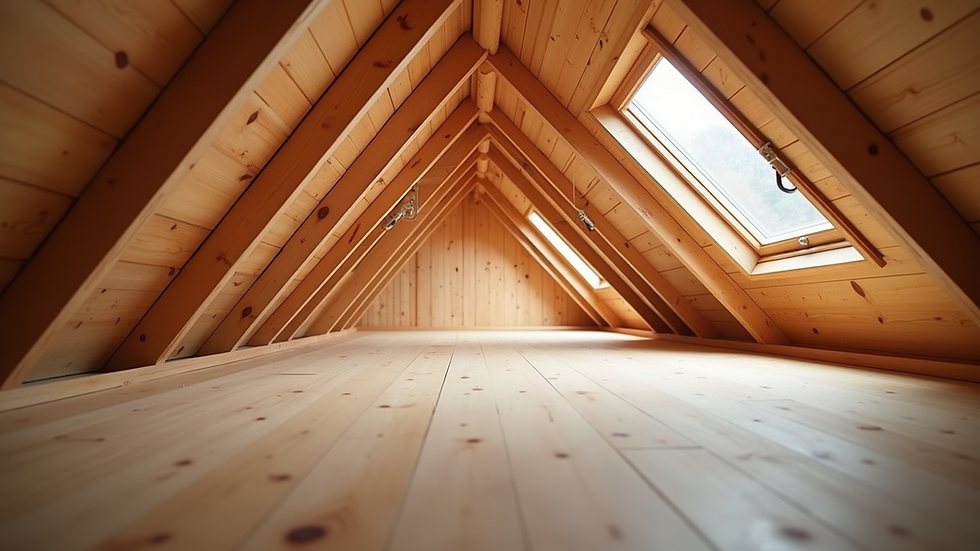
Comments